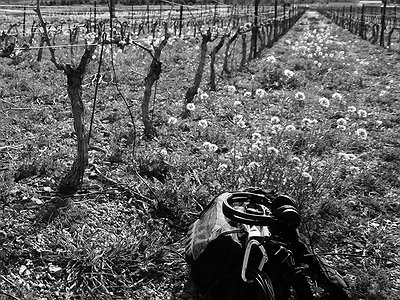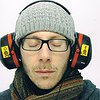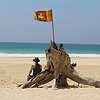Could you describe your creative process on the basis of a piece or album that's particularly dear to you, please? Where did the ideas come from, how were they transformed in your mind, what did you start with and how do you refine these beginnings into the finished work of art?
May I rather talk about a contextual in situ dispositive like “re_COMPOSED re_ALITY” instead of a finished composition? My first intuition of this dispositive was in 2012 in Singapore. I was commissioned by the Singapore Arts Council to compose a soundwalk called “An Umbrella for 2” for the Singapore Arts Festival. A couple of listeners were invited to listen to a site-specific creation within open headphones linked to an audio player. The pre-recorded soundtrack subtly blended with the real ambient sound, native to the place. The headphones were open and always let the sound of the “living” space flow through, having the effect that the “real sound” of the place is expressed, unique, and at the heart of the proposition. On this occasion, I asked Momo, a constructor, to build me a kind of light computer platform where I could easily carry my computer, sound card and controller everywhere in public spaces. My needs was to be able to mix in situ all the tracks without having to come back to the studio, to be able to be as precise as this kind of “augmented” listening walk's mix demands: up to a decibel!
I remember my joy, walking slowly in situ, able to mask/unmask the environmental sounds, playing with my own listening and with the soundscape. Then something happened when I was about to mix a piece in the descent of a kind of a big waterfall fountain leading to the Marina Square's basement parking. Here, I had to mix more than just the intensity: I was interested in mixing more precisely some high frequencies: to let the real sound of the fountain appear slowly and progressively in the mix by finding the accuracy of the best frequency cutting. After this great “in situ” experience, I dreamed about doing this kind of frequency cutting/mixing gesture, not only in terms of recording (to compose a track to be heard later via a soundtrack), but to be able to share IN REAL TIME, IN SITU, this kind of experience of mixing WITH the environment and WITH a walking audience. In that goal, I “just” needed to open live microphones and find a way to transmit the performance to the walking listeners ... 2 years passed by before I found some time and started to run this new project.
As you can imagine “re_COMPOSED re_ALITY“ was born at the frontier between sharing “mix in situ augmented listening” experiences and live field “recording” performance, at the crossing path between artistic wishes and serendipity ...
There are many descriptions of the ideal state of mind for being creative. What is it like for you? What supports this ideal state of mind and what are distractions? Are there strategies to enter into this state more easily?
My idea/practice of creativity depends (not in equal parts ...) to availability, sensitivity and presence (to the environment). In situ, everything that could give you more availability, sensitivity and presence (to the environment) is welcome to be more creative.
How is playing live and writing music in the studio connected? What do you achieve and draw from each experience personally? How do you see the relationship between improvisation and composition in this regard?
From my experience, playing live and writing music are very disconnected! In a studio, I am writing with sounds in terms of constructing a dramaturgy in/with my sequencer: dealing mainly with time. In situ, outdoors, where I am improvising in real time with the sounding environments of public spaces, I am more open to accept unexpected circumstances and develop a lot of improvisations tips to be able to deal with a lot of different sounds/listening situations. Here, improvisation is the opportunity to be engaged more physically with the environment and here's the place to deal mostly with the space dimension. Time at this level become a permanent flux between present and presence.
Furthermore, from another point of view, if we think in terms of phoNography (where the act of composition is concentred in the recording act), we could argue that composing a recording is connected to the sonic flux as you should improvise with all the environmental frameworks that induce this flow.
To go farther, related also to my mix in situ practice: - mixing together in stereo different kind of sounds (e.g.:stereo ambiance mixed with contact and/or hydrophones ...) in the time and by the act of this active/performative recording - as well as to “native binaural recording” - where all your head movement and your body trajectories induce a composed trace into the recording.
In these two particular cases, the act of composition is deeply linked to the state of improvisation with the environment, and the flow of improvisation is always transfixed in this curious and unique composition time: the active/engaged recording session.
How do you see the relationship between the 'sound' aspects of music and the 'composition' aspects? How do you work with sound and timbre to meet certain production ideas and in which way can certain sounds already take on compositional qualities?
In my composition practice, listening is the centre of the process, from recording to studio composing. Most of the time, the timbres, the rhythmical aspects and the energies contained in the sounds are influencing me during the composition time. I don't use a lot of complex sound processing. It's very important to me to collect a great variety of interesting sounds throughout the recording sessions. Each project might focus on a specific aspect (red thread/thematic) but each one is basically based on timbres, rhythms (patterns) and energy contained in the sounds. These specificities invite me to follow the sound where he brings me through the listening process: a real meeting, not a common rendez-vous ...
The sounds show me by themselves the ways to follow. Indeed, in most cases, an idea pre-exists and I need to find recorded/generated sounds to respond to the project idea: this is the case of composing for site-specific project: spaces invite me to give them back some compositional answers. But, when I am working on an album or a radiophonic creation, most of time the “sound aspects” are the very first point of focus, the place where the “composition aspects” will start to emerge, listening after listening. In this context, de-rushing time is a decisive moment, an integral part of the compositional process. Some sounds are “talking” to you, seducing you (for many different reasons), obsessing you. Others will sink into the deep black ocean of oblivion: the world of silence ...
Our sense of hearing shares intriguing connections to other senses. From your experience, what are some of the most inspiring overlaps between different senses - and what do they tell us about the way our senses work? What happens to sound at its outermost borders?
My first inspiring synaesthetic experience (in the domain of my own practice of sound art) happened in 2010, with our first in situ residency for the project “An Umbrella for 2” (“ Un Pépin pour 2” - L'Atelline – Villeneuve lès Maguelone - France). As people were walking under an umbrella, I had the basic intuition to work especially on the poetry of water. I was expecting that in this context the water sounds might work like a frame-within-the frame to create some new elemental perspectives / connections in the urban spaces. But I didn’t realise yet that the result would become as efficient and palpable via another sense (than the listening). I remember me listening to the rain falling on my umbrella (virtually created by the recording) in a dry summer context, and step by step, drip after drip, all the “wet” aspect of my environment were slowly revealed to my eyes: dew on the windshields of the cars parked in the streets, moisture stains on the walls, then special attention to the gutters ... None of these “details” were revealed to my eyes before I was contextually listening to these rainy sounds. I could add that this very evening, I can feel some freshness in the air that doesn't exist yet ...
But maybe the most powerful and curious experience of this kind of synaesthetic experience occurred on the occasion of the “ZAT” festival in Malbosc Parc (Montpellier – France). I was invited to present three of my sound naps at the bottom of a kind of hill overlooking the site. The whole site was designed with fire installations by Carabosse Cie. I can remember this stunning experience while listening to water sounds, eyes open on the site glittering with these thousand lights of fire. The elemental connection subtly arose when the sparks started to become more and more liquid to my eyes, dancing fluently in the dark, as the wet sounds became more and more crispy, revealing the interconnections between senses and elements.
I can't count all kinds of experiences our “augmented” listening dispositive offers to listeners in situ. Here are three last examples:
- closing our eyes and listening to the wind in the trees (in our anti-noise headphone), makes us feel the subtle air flow and suddenly causes goose-bumps...
- an acoustic zoom makes us listen to the sea in the background of the soundscape, waves coming closer, step by step, then closest as possible before our microphones definitely sink into water bubbles ... as our eyes follow this aural zoom movement, they become more and more accurate and reduce the view distance from a seaside landscape to this single wave crushing on the pier of the port.
- extreme circles panoramic movements listen inside a flow of people during rush hour on a train station make us unbalance ourselves as our feet become blurry and crazy confused about the right and left?
Art can be a purpose in its own right, but it can also directly feed back into everyday life, take on a social and political role and lead to more engagement. Can you describe your approach to art and being an artist?
Being involved in environmental and contextual sound art, linked with public spaces, offers a very special position in the framework of artistic actions and connections. Sharing a soundwalk is a kind of socio-political po-ethic act where listening together might be interpreted as a new kind of socio-aesthetic link. Sharing a soundscape's experience is really different than listening to a concert in a dedicated place. In the case of soundwalks, everyone can experience the intimate connections between each listeners and the environment. Sharing this kind of experiences invite you to become a channel between people and their environment. This position is something like a very important responsibility, as it is also a space where we could experiment the world together in a more ludic attitude.
“Re-enchanting the public spaces” is a well-known goal where our artistic path is obviously engaged. But I prefer to talk about “re-situating yourself”, using listening, to be here and now. De-consumerised, de-usefullised public spaces are other goals. Re-sensitising places by walking and listening is an opportunity to offer other ways to people to apprehend their own environment. For this purpose, I am engaged in an acoustic ecology based on a non-discriminative attitude versus any kind of sounds. Here, unexpected goals have appeared to me over the last years, as my artistic path has come closer to acoustic ecology, mutating my artistic position in society, and pushing me every day to come closer to an educational role: something like a „listening facilitator“. In this dimension, I'm engaged with inviting listeners (mostly urban) to be more attentive and more caring to their „polluted“ environment, and trying, step-by-step, to listen to the sounds manifestations in a more aesthetic attitude. My goal is the opposite of a „sound policy“ (based on a quantitative approach of the noise): I try to qualitatively open my ears like other people try to open their eyes, in an open-minded perspective.
2 recent projects („Reflets d'Écoutes“ a soundwalk listening to the Bièvre and its inhabitants (in the framework of the re-opening / re-emerging a part of the groundwater river – Des Ricochets sur les Pavés - 2018) and „Urban cartophony“ part of the „Urban Ma(r)kers“ - L'Esquisse Commune (ULB – Ixelles - 2017)) convinced me that a sound artist has a real socio-political po-ethical role in the city and its planning, not only in term of valorisation of the patrimony but also in term of dialogue, projections, decisions, and why not in the future: realisations ?!
It is remarkable, in a way, that we have arrived in the 21st century with the basic concept of music still intact. Do you have a vision of music, an idea of what music could be beyond its current form?
I dream about a music acting like a revelator of time(s) and space(s) and which could engage us with our environment in a more active manner. Not a music tending to be listened to only for its own sake but a contextual music you should listen through / with. Sonic flux operating like frameworks and which could design the soundscape like an open window does, like a closed window with a purple curtain does, like Venetian blinds half tend (between our ears and the sonic environment) to do ... I am dreaming about musicians playing live WITH the environment not only dealing with all these silent, close and dedicated spaces, but in deep connection to the „real“ sonic environment. I am not talking about musicians playing their own instruments, I am thinking about musicians playing with concrete sounds found in situ (maybe by the use of microphones), in a state of curiosity, openness to this sonic meeting, not only on a position of dominating sound spaces' ...




